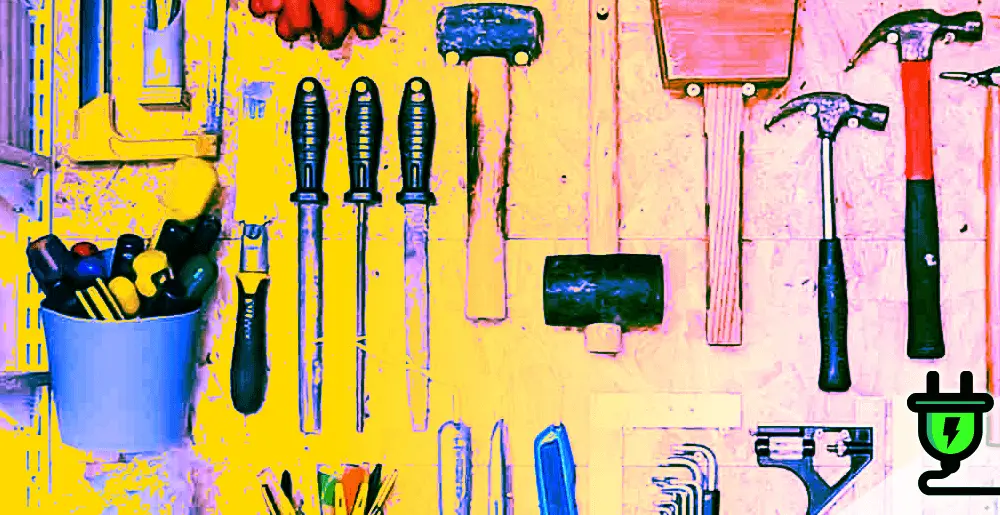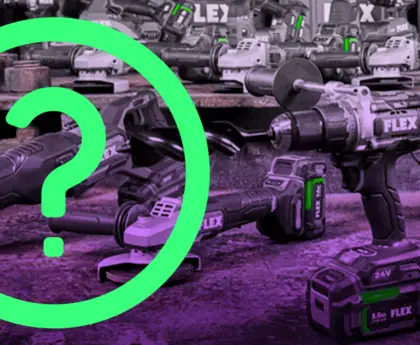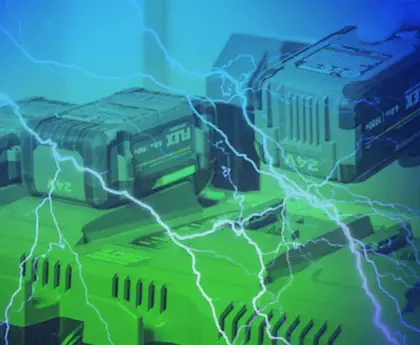Are your power tools strewn haphazardly around your work area, making it hard to find what you need? Here’s a fact: Proper storage extends the life of these invaluable tools.
Store power tools in a clean, dry environment, ideally in their original cases or on pegboards. For corded tools, avoid storing by the cord and ensure cords aren’t tightly wrapped. For battery-operated tools, store batteries in a cool place, preferably at 50% charge for extended periods. Ensure tools with blades have guards, and consider secure locations to prevent theft. Regularly maintain tools for longevity.
Truth is, different tools require slightly more care than some others. This article offers tons of practical tips and innovative solutions for storing power tools efficiently. How to store power tools
Ready to turn chaos into order? Let’s dive in!
Factors to Consider in Power Tool Storage
When it comes to storing power tools, there are several factors to consider such as the size and weight of the tools, as well as how frequently they are used.
Size and weight of tools
Big tools need more space. Small tools need less space. A heavy tool needs strong storage. Plan for the size and weight of your tools. Bigger power tools like table saws can go on the bottom shelf of a rack.
Lighter ones can be hung up high on a wall pegboard. Always make sure that your storage is strong enough to hold your heaviest tool.
Frequency of use
Some power tools are used frequently, while others are only needed occasionally. When storing power tools, it’s important to consider their frequency of use. Tools that are used often should be easily accessible and within reach.
This makes it more convenient to grab them whenever you need them for your DIY projects or repairs. On the other hand, if you have tools that are rarely used, they can be stored in a less accessible location to free up space and keep things organized.
By considering the frequency of use when deciding where to store your power tools, you can ensure that they are readily available when you need them and also maximize the efficiency of your storage system.
Security and protection
When it comes to storing power tools, security and protection are important factors to consider. You want to ensure that your tools are kept safe from theft or damage. One way to enhance security is by using lockable storage cabinets or drawers.
These can help prevent unauthorized access and keep your tools organized at the same time. Additionally, you may also want to invest in a security system for your workshop or garage, such as CCTV cameras or motion sensors.
This will provide an extra layer of protection for your valuable power tools. Remember, it’s always better to be safe than sorry when it comes to protecting your tools from potential risks.
Different Storage Options for Power Tools
There are several different storage options available for power tools, including custom storage systems, drawers and cabinets, pegboards and wall hooks, tool bags and cases, rollaway workstations, and vertical storage solutions.
Custom storage systems
Custom storage systems are a great option for power tool storage because they can be tailored to fit your specific needs. These systems can include shelves, cabinets, and racks that are designed to hold different types of tools.
With custom storage systems, you can easily organize your power tools based on size, function, or usage frequency. They also provide added security and protection for your tools by keeping them locked away when not in use.
Custom storage systems are a practical solution for those who want a more personalized and efficient way to store their power tools.
Drawers and cabinets
Drawers and cabinets are a popular storage option for power tools. They provide a secure and organized space to keep your tools in one place. With drawers, you can separate different types of tools, making it easier to find what you need.
Cabinets are larger and can accommodate bigger power tools like saws or drills. Some cabinets even have built-in shelves for added storage space. It’s important to label the drawers or use dividers to keep everything organized.
Storing power tools in drawers and cabinets also helps protect them from dust and damage, ensuring they stay in good condition for longer.
Pegboards and wall hooks
A simple and cost-effective solution for storing power tools is to use pegboards and wall hooks. These can be easily installed on the walls of your garage or workspace, allowing you to hang your power tools up and keep them organized.
By using different sizes of hooks, you can accommodate various types of power tools, from drills to saws. Pegboards also offer flexibility as you can adjust the hooks based on the size and weight of each tool.
With this storage method, you’ll have easy access to your power tools whenever you need them.
Tool bags and cases
Tool bags and cases are a convenient storage option for power tools. They come in various sizes and designs to accommodate different types of tools. Tool bags have multiple compartments and pockets to keep tools organized and easily accessible.
Cases, on the other hand, provide added protection against dust, moisture, and accidental damage. They are especially useful when transporting or traveling with power tools. Storing power tools in tool bags or cases helps prolong their lifespan by keeping them clean and safe from potential hazards.
Rollaway workstations
Rollaway workstations are a convenient storage option for power tools. These workstations typically have drawers and shelves where you can keep your tools organized and easily accessible.
They also come with wheels, allowing you to move the workstation around your workspace as needed. This mobility is especially useful if you have a large workshop or need to bring your tools to different locations.
Rollaway workstations provide a sturdy and secure place to store your power tools, protecting them from damage while keeping them within reach whenever you need them.
Vertical storage solutions
Vertical storage solutions are a great way to save space and keep your power tools organized. One option is to use a pegboard, where you can hang your tools on hooks. This allows you to easily see and access each tool when you need it.
Another vertical storage solution is using shelves or racks that can be mounted on the wall. This provides a dedicated space for each tool, making it easy to find what you need quickly.
Vertical storage solutions are especially useful if you have limited floor space in your workshop or garage. By utilizing the walls, you can keep your power tools out of the way while still keeping them within reach when needed.
Tips for Organizing Power Tools
Group tools by type or function, label storage containers, keep frequently used tools easily accessible, use dividers or foam inserts for added protection, and utilize empty spaces near power tools.
Efficient organization can save you time and make your work area more efficient. Read on to find out more about organizing your power tools.
Group tools by type or function
To keep your power tools organized, it’s a good idea to group them together based on their type or function. This makes it easier to find the tool you need when you’re working on a specific task.
For example, you can create separate storage areas for drills, saws, and sanders. By grouping tools in this way, you’ll save time searching for what you need and ensure that everything is in its proper place.
It also helps to label each storage container so you know exactly where each tool belongs. With this simple organizing tip, your power tools will be easy to find and ready for use whenever you need them.
Label storage containers
Labeling storage containers is an essential step in organizing power tools. By clearly labeling the containers, you can easily identify and locate specific tools when needed. This saves time and effort, especially if you have a large collection of power tools.
You can use adhesive labels or markers to write the names or descriptions of each tool on the containers. Additionally, consider using color-coded labels for different categories of tools to further simplify the identification process.
Labeling will not only help keep your workspace tidy but also ensure that you always know where your power tools are stored.
Keep frequently used tools easily accessible
To ensure that you can easily find and use your frequently used power tools, it’s important to keep them easily accessible. One way to do this is by using a tool rack or pegboard. These storage solutions allow you to hang your tools on the wall so that they are within reach whenever you need them.
Another option is to use a rollaway workstation, which provides both storage space and a portable work surface. This allows you to move your tools around as needed, making them readily available wherever you’re working.
By keeping your frequently used tools in a convenient location, you can save time and effort during your DIY projects or repairs.
Use dividers or foam inserts for added protection
To provide added protection for your power tools during storage, consider using dividers or foam inserts. Dividers can be placed in drawers or cabinets to create separate compartments for each tool, preventing them from knocking into each other and causing damage.
Foam inserts are soft and cushiony, providing a protective layer around the tools to prevent any scratches or dings. By using dividers or foam inserts, you can ensure that your power tools remain in good condition and are ready for use whenever you need them.
Utilize empty spaces near power tools
Make the most of the empty spaces near your power tools to maximize storage efficiency. For example, you can install small shelves or hooks on the walls adjacent to your power tool storage area.
This will allow you to hang smaller tools or accessories, such as drill bits or wrenches, within easy reach. You can also use magnetic strips or trays to hold metal tools like screwdrivers and pliers.
Additionally, consider using stackable bins or containers that can be placed on top of your power tool cabinets or workstations to store smaller items like sandpaper, screws, nails, and other supplies.
Maintaining and Caring for Stored Power Tools
Regular maintenance and care is essential for stored power tools to ensure their longevity. From cleaning before storage to inspecting and lubricating regularly, these simple steps will help keep your tools in optimal condition.
Don’t forget to store them in a dry and temperature-controlled environment, replace worn or damaged storage equipment, and always follow the manufacturer’s guidelines. Read on for more tips on maintaining and caring for your power tools!
Clean tools before storage
Before storing your power tools, it’s important to give them a good cleaning. This helps remove any dirt, dust, or debris that may have accumulated while using the tools. Cleaning them also prevents rust and corrosion from forming, which can damage the tool over time.
You can clean your power tools by wiping them down with a dry cloth or using a brush to remove loose particles. For tougher stains or grease buildup, you can use a mild detergent or degreaser.
Just make sure to dry the tools thoroughly before storing them to prevent any moisture-related issues. By cleaning your power tools before storage, you’ll ensure that they stay in good condition and are ready for use when you need them next.
Regularly inspect and lubricate tools
To ensure the longevity and performance of your power tools, it is important to regularly inspect and lubricate them. Inspecting your tools allows you to identify any signs of wear or damage that may affect their functionality.
You can check for loose parts, frayed cords, or dull blades. Lubricating your tools helps reduce friction and keeps them running smoothly. Applying a few drops of oil to moving parts like gears, bearings, and joints can prevent rusting and corrosion.
By taking the time to inspect and lubricate your tools on a regular basis, you can extend their lifespan and maintain optimal performance.
Store tools in a dry and temperature-controlled environment
To keep your power tools in good condition, it’s important to store them in a dry and temperature-controlled environment. This means avoiding areas that are too hot, cold, humid, or damp.
Extreme temperatures and humidity can damage the tools and affect their performance. It is recommended to store them away from direct sunlight and sources of heat or moisture. Keep your power tools protected by storing them in a cool and well-ventilated space.
Replace worn or damaged storage equipment
If your storage equipment for power tools is worn or damaged, it’s important to replace it. Using old or broken storage solutions can increase the risk of accidents and damage to your tools.
Look for signs of wear and tear such as rust, cracks, or loose parts. Invest in new storage options that are sturdy and reliable to ensure the safety and organization of your power tools.
By replacing worn or damaged storage equipment, you can maintain a neat and efficient workspace while also prolonging the life of your tools.
How to store power tools FAQs
How should I store power tools to keep them in good condition?
To keep power tools in good condition, store them in a clean and dry area away from moisture and dust. Use protective cases or toolboxes to prevent damage and ensure they are safely stored.
Should I remove the batteries before storing power tools?
Yes, it is recommended to remove the batteries from power tools before storing them. This helps prevent battery drain and potential damage due to leakage or corrosion.
How often should I inspect my stored power tools?
It is important to regularly inspect your stored power tools, at least once every few months, to check for any signs of damage or wear. This helps ensure they are functioning properly when you need them.
Can I hang power tools for storage?
Yes, you can hang certain types of power tools for storage using hooks or pegboards. However, make sure they are securely fastened and do not hang heavy or bulky tools that could cause accidents or strain on the hanging mechanism.
Conclusion: How to store power tools
So there you have it – practical tips for how to store power tools. Fact is, proper storage of power tools is essential to protect them from damage and ensure their longevity. By considering factors such as tool size, frequency of use, and security needs, you can choose the best storage option for your needs.
Remember to organize your tools by type or function, label containers, and keep frequently used tools easily accessible. Don’t forget to regularly maintain and care for your stored power tools to keep them in top working condition.
With these tips in mind, you’ll have a well-organized workshop with all your power tools ready for any DIY project!






